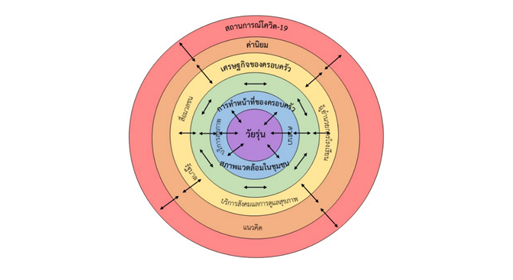Factors Predicting Domestic Violence of Adolescents during Covid-19 Pandemic
Keywords:
COVID-19, Domestic Violence, Teenagers, COVID-19 situation, domestic violence, teenagers/ adolescentsAbstract
This descriptive research aimed to study the risk and predictive factors of domestic violence in adolescents during the COVID-19. The sample group were 130 high-school students, aged 13-18 years old, studying at a school in Nakhon Ratchasima Province. Data were collected by two online questionnaires: one was titled Factors affecting domestic violence during Covid-19 (Cronbach's alpha coefficient = .71), and the other was called Domestic violence pattern questionnaire (Cronbach's alpha coefficient = .70). Both were validated by a qualified content reviewer (CVI), yielding a score of .98. Data were analyzed by percentage, mean, standard deviation, Pearson's correlation coefficient and Multiple regression.
1. The results showed that the sample group had an average age of 15.10 years. Their parents were government officials/employees. Status of parents was living together. Most of the students lived with their parents and siblings. The sample group reported an overall domestic violence at the lowest level (M=1.72, SD=0.58). Considering each aspect, it was found that psychological violence was at the highest level (M=2.55, SD=1.05).
2. This research showed that the family functioning factor had a statistically significant negative correlation with domestic violence among adolescents in the Covid-19 situation (r = -.695, p-value <.01). The environment had a statistically significant negative relationship at a low level (r = -.212, p-value <.01). Factors affecting domestic violence among adolescents during covid-19 pandemic was family functioning (Beta = -.695). This factor could significantly explain 47.80 % of variance (adj.R2 = .478, p-value <.001).
Health care workers should involve in the care of adolescents and their families. Family violence should be monitored. In addition, family functioning should be assessed before designing protection or reducing domestic violence among adolescents especially adolescents who have a difficult family relationship and environment.
References
Best, J. W. (1977). Research in Education. 3rd ed. New Jersey: Prentice Hall.
Bronfenbrenner, U. (2005). Making Human Beings Human: Bioecological Perspectives on Human Development. Thousand Oaks, California: Sage.
Chaffin, M., Silovsky, J. F., Funderburk, B., Valle, L. A., Brestan, E. V., Balachova, et al. (2004). Parent-Child Interaction Therapy with Physically Abusive Parents: Efficacy for Reducing Future abuse Reports. Journal of Consulting and Clinical Psychology, 72: 500-510.
Child Welfare Information Gateway. (2013). Definitions of Domestic Violence. Washington, DC: U.S. Department of Health and Human Services, Children’s Bureau.
Cohen, J. (1988). Statistical power analysis for the behavioral sciences. 2nd ed. Hillsdale, NJ: Lawrence Erlbaum Associates, Publishers.
Department of Disease Control: Division of Communicable Diseases. (2023). Guidelines for Monitoring and Control Covid-19 for Medical and Public Health Personnel. Retrieved March 29, 2023 from https://ddc.moph.go.th/uploads/publish/11509202106 10033910.pdf. (in Thai).
Department of Health. (2021). Summary of Global Statistics Reports of COVID-19. Retrieved July 25, 2021 from https://ddc.moph.go.th/viralpneumonia/ situation.php. (in Thai).
Doungsuwan, N., Kaewkabthong, H., Thankan,W., Saesa, N. & Jehtae, H. (2022). Children and Domestic Violence. Journal of Social Work, 30(1), 178-216.
Hair, F.J., Black, C.W., Babin, J.B, & Anderson, E.R. (2019). Multivariate Data Analysis 7th ed. New Jersey: Pearson Education.
Ministry of Social Development and Human Security. (2013). The Results of the Survey on the Situation of Violence in 76 Provinces in 2013. Retrieved October 5, 2017, from https:// www.m-society.go.th/article_attach/11400/15717.pdf. (in Thai)
National Statistical Office. (2021). 8 Statistics of household income and expenses. Retrieved October 25, 2021 from http://statbbi.nso.go.th/staticreport/page/sector/th/08.aspx. (in Thai).
Office of the National Human Rights Commission of Thailand. (2020). Family violence is a silent threat in the crisis of COVID-19. Perspectives on rights, 19(4), 1-8. Retrieved July 15, 2022 from http://www.nhrc.or.th/getattachment/774d6a06-4348-414b-ba9c-f03b984aa4e2/.aspx.
Office of the Permanent Secretary for Ministry of Social Development and Human Security. (2015). Network Operations Manual for Surveillance and Warning of the Risk of Domestic Violence. Bangkok: Department of Social Development and Welfare. (in Thai).
Polit, D. E. & Beck, C. T. (2004). Nursing Research: Principles and Methods. 7th Edition, Lippincott Williams & Young, Philadelphia.
Royal Thai Government Gazette. (2007). The Act on the Protection of Victims of Domestic Violence. Retrieved January 3, 2017, from www.thailawforum.com › Thailand Laws Database. (in Thai)
Sanitlou, N., Sartphet, W. & Naphaarrak, Y. (2019). Sample Size Calculation Using G*Power Program. Journal of Suvarnabhumi Institute of Technology, 5(1), 496-507. (in Thai).
Sanprasit, Y., Boonprakob, P., Kongsakon, R. & Intarakamhang, U. (2011). Domestic Violence Prevention Model with Participatory Action of Families and Community: A Case Study of a Community in Pathumthani Province. Journal of Behavioral Science, 17(2), 19-36. (in Thai).
Senglem, A., Nintachan, P. & Piaseu, N. (2011). A synthesis of research on factors related to Domestic violence among women in Thai society. The Journal of Psychiatric Nursing and Mental Health, 25(3), 38-55. (in Thai).
Wacharasin, C., Sriprasan C., Chivanon, N. & Khamngoen, R. (2020). Factors Related to Violence in Families with School Age Children. The Southern College Network Journal of Nursing and Public Health, 5(2), 189-200. (in Thai).

Downloads
Published
Issue
Section
License
Copyright (c) 2023 The Southern College Network Journal of Nursing and Public Health

This work is licensed under a Creative Commons Attribution-NonCommercial-NoDerivatives 4.0 International License.
1. บทความหรือข้อคิดเห็นใด ๆ ที่ปรากฏในวารสารเครือข่าย วิทยาลัยพยาบาลและการสาธารณสุขภาคใต้ ที่เป็นวรรณกรรมของผู้เขียน บรรณาธิการหรือเครือข่ายวิทยาลัยพยาบาลและวิทยาลัยการสาธารณสุขภาคใต้ ไม่จำเป็นต้องเห็นด้วย
2. บทความที่ได้รับการตีพิมพ์ถือเป็นลิขสิทธิ์ของ วารสารเครือข่ายวิทยาลัยพยาบาลและการสาธารณสุขภาคใต้







